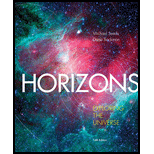
Horizons: Exploring the Universe (MindTap Course List)
14th Edition
ISBN: 9781305960961
Author: Michael A. Seeds, Dana Backman
Publisher: Cengage Learning
expand_more
expand_more
format_list_bulleted
Textbook Question
Chapter 15, Problem 7P
Suppose that Earth grew to its present size in 1 million years through the accretion of particles averaging 100 grams each. On the average, how many particles did Earth capture per second? (Note: Earth’s mass is
Expert Solution & Answer
Want to see the full answer?
Check out a sample textbook solution
Students have asked these similar questions
What is the significance of size of the planet and its atmostphere in supporting life? What two planets have the possibility in supporting life like earth?
Chapter 15 Solutions
Horizons: Exploring the Universe (MindTap Course List)
Ch. 15 - What produced the helium now present in the Sun’s...Ch. 15 - What produced the iron and heavier elements like...Ch. 15 - What evidence can you cite that disks of gas and...Ch. 15 - According to the solar nebula theory, why is the...Ch. 15 - Why does the solar nebula theory predict that...Ch. 15 - Prob. 6RQCh. 15 - If you visited another planetary system, would you...Ch. 15 - Why is almost every solid surface in our Solar...Ch. 15 - What is the difference between condensation and...Ch. 15 - Why don’t Terrestrial planets have rings like the...
Ch. 15 - How does the solar nebula theory help you...Ch. 15 - How does the solar nebula theory explain the...Ch. 15 - What does the term differentiated mean when...Ch. 15 - What processes cleared the nebula away and ended...Ch. 15 - Why would astronomically short lifetime of gas and...Ch. 15 - Prob. 16RQCh. 15 - What evidence can you cite that planets orbit...Ch. 15 - Why is the existence of “hot Jupiters” puzzling?...Ch. 15 - How Do We know? The evidence is overwhelming in...Ch. 15 - How Do We know? How can scientists know anything...Ch. 15 - If you could visit another planetary system while...Ch. 15 - Prob. 2DQCh. 15 - If the solar nebula hypothesis is correct, do you...Ch. 15 - If you observed the Solar System from the nearest...Ch. 15 - Prob. 2PCh. 15 - Prob. 3PCh. 15 - Prob. 4PCh. 15 - Prob. 5PCh. 15 - Prob. 6PCh. 15 - Suppose that Earth grew to its present size in 1...Ch. 15 - Prob. 8PCh. 15 - Prob. 9PCh. 15 - Prob. 1LTLCh. 15 - Why do astronomers conclude that the surface of...Ch. 15 - Prob. 3LTL
Knowledge Booster
Learn more about
Need a deep-dive on the concept behind this application? Look no further. Learn more about this topic, physics and related others by exploring similar questions and additional content below.Similar questions
- How can a planet’s atmosphere affect the width of the habitable zone in its planetary system?arrow_forwardWhere is the oxygen on Mars today? How do you know?arrow_forwardIf you detected radio signals with an average wavelength of 20.000 cm and suspected that they came from a civilization on a distant Earth-like exoplanet, roughly how much of a change in wavelength should you expect to detect as a result of the orbital motion of the distant exoplanet? (Hint: Use the Doppler shift formula, Eq. 7-3.) (Note: Earths orbital velocity is 30 km/s.)arrow_forward
- Astronomers believe that the deposit of lava in the giant mare basins did not happen in one flow but in many different eruptions spanning some time. Indeed, in any one mare, we find a variety of rock ages, typically spanning about 100 million years. The individual lava flows as seen in Hadley Rille by the Apollo 15 astronauts were about 4mthick. Estimate the average time interval between the beginnings of successive lava flows if the total depth of the lava in the mare is 2 km.arrow_forwardWhat is a habitable zone?arrow_forward
arrow_back_ios
arrow_forward_ios
Recommended textbooks for you
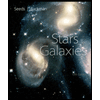 Stars and Galaxies (MindTap Course List)PhysicsISBN:9781337399944Author:Michael A. SeedsPublisher:Cengage Learning
Stars and Galaxies (MindTap Course List)PhysicsISBN:9781337399944Author:Michael A. SeedsPublisher:Cengage Learning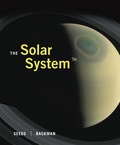
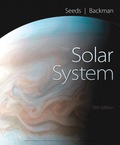
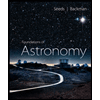 Foundations of Astronomy (MindTap Course List)PhysicsISBN:9781337399920Author:Michael A. Seeds, Dana BackmanPublisher:Cengage Learning
Foundations of Astronomy (MindTap Course List)PhysicsISBN:9781337399920Author:Michael A. Seeds, Dana BackmanPublisher:Cengage Learning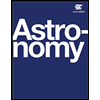 AstronomyPhysicsISBN:9781938168284Author:Andrew Fraknoi; David Morrison; Sidney C. WolffPublisher:OpenStax
AstronomyPhysicsISBN:9781938168284Author:Andrew Fraknoi; David Morrison; Sidney C. WolffPublisher:OpenStax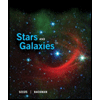 Stars and GalaxiesPhysicsISBN:9781305120785Author:Michael A. Seeds, Dana BackmanPublisher:Cengage Learning
Stars and GalaxiesPhysicsISBN:9781305120785Author:Michael A. Seeds, Dana BackmanPublisher:Cengage Learning

Stars and Galaxies (MindTap Course List)
Physics
ISBN:9781337399944
Author:Michael A. Seeds
Publisher:Cengage Learning



Foundations of Astronomy (MindTap Course List)
Physics
ISBN:9781337399920
Author:Michael A. Seeds, Dana Backman
Publisher:Cengage Learning

Astronomy
Physics
ISBN:9781938168284
Author:Andrew Fraknoi; David Morrison; Sidney C. Wolff
Publisher:OpenStax

Stars and Galaxies
Physics
ISBN:9781305120785
Author:Michael A. Seeds, Dana Backman
Publisher:Cengage Learning
Kepler's Three Laws Explained; Author: PhysicsHigh;https://www.youtube.com/watch?v=kyR6EO_RMKE;License: Standard YouTube License, CC-BY